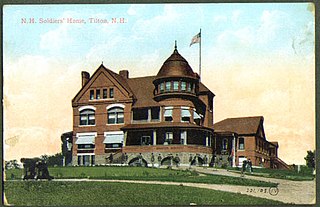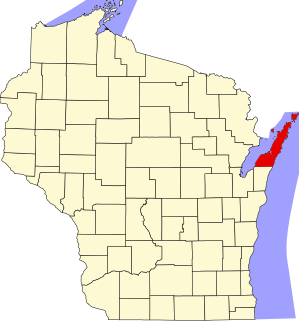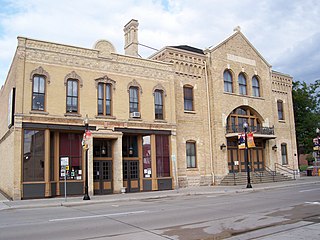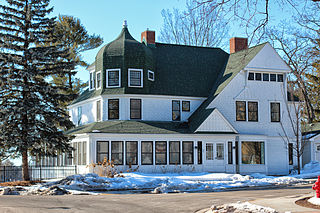
An old soldiers' home is a military veterans' retirement home, nursing home, or hospital, or sometimes an institution for the care of the widows and orphans of a nation's soldiers, sailors, and marines, etc.
Black Point may refer to:
The Confederate Memorial State Historic Site is a state-owned property occupying approximately 135 acres (55 ha) near Higginsville, Missouri. From 1891 to 1950, the site was used as an old soldiers' home for veterans of the Confederate States Army after the American Civil War. The Missouri state government then took over operation of the site after the last veteran died in 1950, using it as a state park. In 1981, a cottage, a chapel, and the Confederate cemetery were listed on the National Register of Historic Places as the Confederate Chapel, Cemetery and Cottage. The chapel was moved from its original position in 1913, but was returned in 1978. It has a tower and a stained glass window. The cottage is a small wooden building, and the cemetery contains 723 graves. Within the cemetery is a monument erected by the United Daughters of the Confederacy which is modeled on the Lion of Lucerne. In addition to the cemetery and historic structures, the grounds also contain trails, picnic sites, and fishing ponds.
Mendota Mental Health Institute (MMHI) is a public psychiatric hospital in Madison, Wisconsin, United States, operated by the Wisconsin Department of Health Services. The hospital is accredited by the Joint Commission. Portions of the facility are included in the Wisconsin Memorial Hospital Historic District, District #88002183. The Mendota State Hospital Mound Group and Farwell's Point Mound Group are also located at the facility.

The Seth Peterson Cottage is a two-room lakeside cottage located in Mirror Lake State Park outside Lake Delton, Wisconsin, United States. It was designed by Frank Lloyd Wright in 1958.

The American System-Built Homes were modest houses designed by architect Frank Lloyd Wright. They were developed between 1912 and 1916 to fulfill his interest in affordable housing. Wright was devoted to the idea of providing beautiful yet affordable homes to the public. His firm produced over 960 drawings for the project, the largest number of drawings for any project in the Wright archives. The designs were standardized, and customers could choose from seven models. Because of this standardization, the lumber could be precut at the factory, thereby cutting down on both waste and the amount of skilled labor needed for construction. The buildings are often termed prefabricated homes, but they were not, since no parts of the homes were constructed off-site. The lumber was cut at the factory, packaged along with all other components, and delivered to the work site for construction. Some are located in a federal historic district in Milwaukee, Wisconsin, and others have been designated Chicago Landmarks in Chicago, Illinois.

Grant Cottage State Historic Site is an Adirondack mountain cottage on the slope of Mount McGregor in the town of Moreau, New York. Ulysses S. Grant, the 18th President of the United States, died of throat cancer at the cottage on July 23, 1885. The house was maintained as a shrine to U.S. Grant following his death by the Mount McGregor Memorial Association and a series of live-in caretakers. The building became a New York State Historic Site in 1957 and was added to the National Register of Historic Places in 1971. The Historic Site was designated a National Historic Landmark by the National Park Service in 2021.

Between 1873 and 1945, Saranac Lake, New York, became a world-renowned center for the treatment of tuberculosis, using a treatment that involved exposing patients to as much fresh air as possible under conditions of complete bed-rest. In the process, a specific building type, the "cure cottage", developed, built by residents seeking to capitalize on the town's fame, by physicians, and often by the patients themselves. Many of these structures are extant, and their historic value has been recognized by listing on The National Register of Historic Places.

This is a list of the National Register of Historic Places listings in Brown County, Wisconsin. It is intended to provide a comprehensive listing of entries in the National Register of Historic Places that are located in Brown County, Wisconsin. The locations of National Register properties for which the latitude and longitude coordinates are included below may be seen in a map.

This is a list of the National Register of Historic Places listings in Door County, Wisconsin. It is intended to provide a comprehensive listing of entries in the National Register of Historic Places that are located in Door County, Wisconsin. The locations of National Register properties for which the latitude and longitude coordinates are included below may be seen in a map.

The Minnesota Home School for Girls was a reformatory in Sauk Centre, Minnesota, United States. It was Minnesota's first single-sex reformatory for girls from its establishment in 1911 to 1967, when it switched to a coeducational model and shortened its name to the Minnesota Home School. The facility closed in 1999. The campus was designed on the Cottage Plan, with dispersed buildings in a bucolic setting, by Minnesota state architect Clarence H. Johnston Sr. The site has been converted to a veteran care center called Eagle's Healing Nest.

King is a census-designated place in Town of Farmington, Waupaca County, Wisconsin. As of the 2010 census, it had a population of 1,750. Before 2010, it was part of the Chain O' Lakes-King, Wisconsin CDP.

William Waters (1843–1917) was an American architect who designed numerous buildings in Wisconsin that eventually were listed on the National Register of Historic Places. He was responsible for designing much of historic Oshkosh, Wisconsin. He was also responsible for designing the Wisconsin building for the Columbian Exposition. Waters died in 1917 and is buried at Riverside Cemetery in Oshkosh. After his death, Oshkosh honored him by naming the intersection of Washington Avenue and State Street as the "William Waters Plaza".

The Cottage Home Historic District is a historic district and neighborhood located on the near east side of Indianapolis, Indiana. A small portion of Cottage Home is listed on the National Register of Historic Places while a larger area is listed on the state and local levels. Known for its preponderance of "cottage-style" homes built with strong Victorian influences, Cottage Home has historically been a working class neighborhood. Numerous industrial buildings are also scattered throughout the district, providing a base of economic activity. Today, however, many of these buildings are vacant, providing a special challenge to preservation and urban renewal efforts.

The Veterans Home Chapel is located in King, Waupaca County, Wisconsin on the grounds of the Wisconsin Veterans Home. It was added to the National Register of Historic Places in 1985.

The Wisconsin Veterans' Home, in King Wisconsin, is an old soldiers' home in Waupaca County, Wisconsin on the scenic Chain O' Lakes, Wisconsin.

The Commandant's Residence Home is located in King, Waupaca County, Wisconsin.

The Mitchell-Rountree House is located in Platteville, Wisconsin.

The 40th Assembly District of Wisconsin is one of 99 districts in the Wisconsin State Assembly. Located in central Wisconsin, the district comprises most of Waupaca County and the eastern half of Waushara County. It includes the cities of Manawa, Marion, New London, Waupaca, and Weyauwega, as well as the villages of Big Falls, Fremont, Iola, Ogdensburg, Redgranite, Scandinavia, and Wild Rose. It also contains most of Hartman Creek State Park and historic sites such as Waupaca's Main Street Historic District and the King Wisconsin Veterans Home, established for veterans of the American Civil War, containing the Veterans Cottages Historic District, the Commandant's Residence Home, and the Veterans Home Chapel. The district is represented by Republican Kevin D. Petersen, since January 2007.

The Columbia Historic District is a neighborhood in Cedarburg, Wisconsin, that is listed on the National Register of Historic Places. At the time the district was listed on the register, its contributing properties included 128 historic homes, one church, and eighty-seven historic outbuildings, including garages and barns, all constructed between 1844 and 1938. The district also contained several dozen building that were not considered to contribute to the historic district, including modern homes from the post-war era as well as modern garages and other additions to historic properties.

















